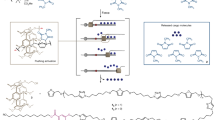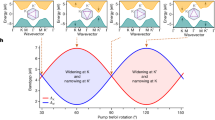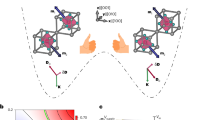Abstract
Singlet fission—that is, the generation of two triplets from a lone singlet state—has recently resurfaced as a promising process for the generation of multiexcitons in organic systems. Although advances in this area have led to the discovery of modular classes of chromophores, controlling the fate of the multiexciton states has been a major challenge; for example, promoting fast multiexciton generation while maintaining long triplet lifetimes. Unravelling the dynamical evolution of the spin- and energy conversion processes from the transition of singlet excitons to correlated triplet pairs and individual triplet excitons is necessary to design materials that are optimized for translational technologies. Here, we engineer molecules featuring a discrete energy gradient that promotes the migration of strongly coupled triplet pairs to a spatially separated, weakly coupled state that readily dissociates into free triplets. This ’energy cleft’ concept allows us to combine the amplification and migration processes within a single molecule, with rapid dissociation of tightly bound triplet pairs into individual triplets that exhibit lifetimes of ~20 µs.
This is a preview of subscription content, access via your institution
Access options
Access Nature and 54 other Nature Portfolio journals
Get Nature+, our best-value online-access subscription
$29.99 / 30 days
cancel any time
Subscribe to this journal
Receive 12 print issues and online access
$259.00 per year
only $21.58 per issue
Buy this article
- Purchase on Springer Link
- Instant access to full article PDF
Prices may be subject to local taxes which are calculated during checkout




Similar content being viewed by others
Data availability
The data supporting the findings of this study are available in the paper and its Supplementary Information; further data are available from the corresponding author on reasonable request.
References
Huber, R. C. et al. Long-lived photoinduced polaron formation in conjugated polyelectrolyte-fullerene assemblies. Science 348, 1340–1343 (2015).
Scholes, G. D. & Rumbles, G. Excitons in nanoscale systems. Nat. Mater. 5, 683–696 (2006).
Albinsson, B. & Mårtensson, J. Long-range electron and excitation energy transfer in donor–bridge–acceptor systems. J. Photochem. Photobiol. C 9, 138–155 (2008).
Hanna, M. C. & Nozik, A. J. Solar conversion efficiency of photovoltaic and photoelectrolysis cells with carrier multiplication absorbers. J. Appl. Phys. 100, 074510 (2006).
Tayebjee, M. J. Y., McCamey, D. R. & Schmidt, T. W. Beyond Shockley–Queisser: molecular approaches to high-efficiency photovoltaics. J. Phys. Chem. Lett. 6, 2367–2378 (2015).
Semonin, O. E., Luther, J. M. & Beard, M. C. Quantum dots for next-generation photovoltaics. Mater. Today 15, 508–515 (2012).
Klimov, V. I., Mikhailovsky, A. A., McBranch, D. W., Leatherdale, C. A. & Bawendi, M. G. Quantization of multiparticle auger rates in semiconductor quantum dots. Science 287, 1011–1013 (2000).
Padilha, L. A. et al. Carrier multiplication in semiconductor nanocrystals: influence of size, shape, and composition. Acc. Chem. Res. 46, 1261–1269 (2013).
Lukman, S. et al. Efficient singlet fission and triplet-pair emission in a family of zethrene diradicaloids. J. Am. Chem. Soc. 139, 18376–18385 (2017).
Pensack, R. D. et al. Observation of two triplet-pair intermediates in singlet exciton fission. J. Phys. Chem. Lett. 7, 2370–2375 (2016).
Weiss, L. R. et al. Strongly exchange-coupled triplet pairs in an organic semiconductor. Nat. Phys. 13, 176–181 (2017).
Stern, H. L. et al. Vibronically coherent ultrafast triplet-pair formation and subsequent thermally activated dissociation control efficient endothermic singlet fission. Nat. Chem. 9, 1205–1212 (2017).
Folie, B. D., Haber, J. B., Refaely-Abramson, S., Neaton, J. B. & Ginsberg, N. S. Long-lived correlated triplet pairs in a π-stacked crystalline pentacene derivative. J. Am. Chem. Soc. 140, 2326–2335 (2018).
Yong, C. K. et al. The entangled triplet pair state in acene and heteroacene materials. Nat. Commun. 8, 15953 (2017).
Tayebjee, M. J. Y. et al. Quintet multiexciton dynamics in singlet fission. Nat. Phys. 13, 182–188 (2017).
Stern, H. L. et al. Identification of a triplet pair intermediate in singlet exciton fission in solution. Proc. Natl Acad. Sci. USA 112, 7656–7661 (2015).
Basel, B. S. et al. Unified model for singlet fission within a non-conjugated covalent pentacene dimer. Nat. Commun. 8, 15171 (2017).
Kumarasamy, E. et al. Properties of poly- and oligopentacenes synthesized from modular building blocks. Macromolecules 49, 1279–1285 (2016).
Kumarasamy, E. et al. Tuning singlet fission in π-bridge-π chromophores. J. Am. Chem. Soc. 139, 12488–12494 (2017).
Pun, A. B. et al. Triplet harvesting from intramolecular singlet fission in polytetracene. Adv. Mater. 29, 1701416 (2017).
Lukman, S. et al. Tuneable singlet exciton fission and triplet–triplet annihilation in an orthogonal pentacene dimer. Adv. Funct. Mater. 25, 5452–5461 (2015).
Korovina, N. V. et al. Singlet fission in a covalently linked cofacial alkynyltetracene dimer. J. Am. Chem. Soc. 138, 617–627 (2016).
Zirzlmeier, J. et al. Singlet fission in pentacene dimers. Proc. Natl Acad. Sci. USA 112, 5325–5330 (2015).
Sanders, S. N. et al. Singlet fission in polypentacene. Chem 1, 505–511 (2016).
Fuemmeler, E. G. et al. A direct mechanism of ultrafast intramolecular singlet fission in pentacene dimers. ACS Cent. Sci. 2, 316–324 (2016).
Lukman, S. et al. Tuning the role of charge-transfer states in intramolecular singlet exciton fission through side-group engineering. Nat. Commun. 7, 13622 (2016).
Xia, J. et al. Singlet fission: progress and prospects in solar cells. Adv. Mater. 29, 1601652 (2017).
Low, J. Z., Sanders, S. N. & Campos, L. M. Correlating structure and function in organic electronics: from single molecule transport to singlet fission. Chem. Mater. 27, 5453–5463 (2015).
Liu, H. et al. A covalently linked tetracene trimer: synthesis and singlet exciton fission property. Org. Lett. 19, 580–583 (2017).
Wang, X. et al. Intramolecular singlet fission in a face-to-face stacked tetracene trimer. Phys. Chem. Chem. Phys. 20, 6330–6336 (2018).
Hetzer, & Guldi, D. M., Tykwinski, R. R., Pentacene dimers as a critical tool for the investigation of intramolecular singlet fission. Chem. Eur. J. 24, 8245–8257 (2018).
Sanders, S. N. et al. Quantitative intramolecular singlet fission in bipentacenes. J. Am. Chem. Soc. 137, 8965–8972 (2015).
Trinh, M. T. et al. Distinct properties of the triplet pair state from singlet fission. Sci. Adv. 3, e1700241 (2017).
Buchanan, E. A., Havlas, Z. & Michl, J. in Advances in Quantum Chemistry: Ratner Volume Vol. 75, 175–227 (Elsevier, 2017).
Kim, H. & Zimmerman, P. M. Coupled double triplet state in singlet fission. Phys. Chem. Chem. Phys. 20, 30083–30094 (2018).
Basel, B. S., et al. Evidence for charge-transfer mediation in the primary events of singlet fission in a weakly-coupled pentacene dimer. Chem 4, 1092–1111 (2018).
Zirzlmeier, J. et al. Solution-based intramolecular singlet fission in cross-conjugated pentacene dimers. Nanoscale 8, 10113–10123 (2016).
Sanders, S. N. et al. Intramolecular singlet fission in oligoacene heterodimers. Angew. Chem. Int. Ed. 55, 3373–3377 (2016).
Vektaris, G. A new approach to the molecular biexciton theory. J. Chem. Phys. 101, 3031–3040 (1994).
Sanders, S. N. et al. Exciton correlations in intramolecular singlet fission. J. Am. Chem. Soc. 138, 7289 (2016).
Khan, S. & Mazumdar, S. Optical probes of the quantum-entangled triplet-triplet state in a heteroacene dimer. Phys. Rev. B 98, 165202 (2018).
Khan, S. & Mazumdar, S. Theory of transient excited state absorptions in pentacene and derivatives: triplet–triplet biexciton versus free triplets. J. Phys. Chem. Lett. 8, 5943–5948 (2017).
Bayliss, S. L. et al. Geminate and nongeminate recombination of triplet excitons formed by singlet fission. Phys. Rev. Lett. 112, 238701 (2014).
Smith, M. B. & Michl, J. Singlet fission. Chem. Rev. 110, 6891–6936 (2010).
Merrifield, R. E. Magnetic effects on triplet exciton interactions. Pure Appl. Chem. 27, 481–498 (1971).
Burdett, J. J. & Bardeen, C. J. Quantum beats in crystalline tetracene delayed fluorescence due to triplet pair coherences produced by direct singlet fission. J. Am. Chem. Soc. 134, 8597–8607 (2012).
Sakuma, T. et al. Long-lived triplet excited states of bent-shaped pentacene dimers by intramolecular singlet fission. J. Phys. Chem. A 120, 1867–1875 (2016).
Kuroda, K. et al. A pentacene-based nanotube displaying enriched electrochemical and photochemical activities. Angew. Chem. Int. Ed. 58, 1115–1119 (2019).
Zhang, Y.-D. et al. Excessive exoergicity reduces singlet exciton fission efficiency of heteroacenes in solutions. J. Am. Chem. Soc. 138, 6739–6745 (2016).
Okamoto, T. & Bao, Z. Synthesis of solution-soluble pentacene-containing conjugated copolymers. J. Am. Chem. Soc. 129, 10308–10309 (2007).
Acknowledgements
L.M.C. acknowledges support from the Office of Naval Research Young Investigator Program (award no. N00014-15-1-2532) and a Cottrell Scholar Award. S.N.S. and A.B.P. thank the NSF for Graduate Research Fellowship Program (DGE 11-44155). S.N.S. acknowledges the NSF for receipt of a GROW award to perform work at UNSW. This research used resources of the Center for Functional Nanomaterials (which is a US DOE Office of Science Facility) at Brookhaven National Laboratory under contract no. DE-SC0012704. M.J.Y.T. acknowledges receipt of an ARENA Postdoctoral Fellowship and a Marie Sklodowska Curie Individual Fellowship (grant no. 705113). D.R.M. acknowledges support from an Australian Research Council Future Fellowship (grant no. FT130100214) and through the ARC Centre of Excellence in Exciton Science (grant no. CE170100026).
Author information
Authors and Affiliations
Contributions
S.N.S., L.M.C. and M.Y.S. oversaw the project. A.B.P., S.N.S., E.K. and L.M.C. designed the molecules. S.N.S., D.N. and M.Y.S. carried out the transient absorption spectroscopy measurements and data analysis. A.B.P. and E.K. synthesized and characterized the molecules. A.A., M.J.Y.T. and S.N.S. carried out tr-ESR experiments and the data were also analysed by M.Y.S. and D.R.M. S.N.S., L.M.C. and M.Y.S. wrote the paper with contributions from all authors.
Corresponding authors
Ethics declarations
Competing interests
A.B.P., E.K., S.N.S., L.M.C. and M.Y.S. are named as inventors on a patent (WO 2016/100754A1) based on this singlet fission platform.
Additional information
Publisher’s note: Springer Nature remains neutral with regard to jurisdictional claims in published maps and institutional affiliations.
Supplementary information
Supplementary information
Supplementary Figs. 1–14, Supplementary Tables 1 and 2, Supplementary materials and methods, Supplementary data and analysis
Rights and permissions
About this article
Cite this article
Pun, A.B., Asadpoordarvish, A., Kumarasamy, E. et al. Ultra-fast intramolecular singlet fission to persistent multiexcitons by molecular design. Nat. Chem. 11, 821–828 (2019). https://doi.org/10.1038/s41557-019-0297-7
Received:
Accepted:
Published:
Issue Date:
DOI: https://doi.org/10.1038/s41557-019-0297-7
This article is cited by
-
Quantum interference effects elucidate triplet-pair formation dynamics in intramolecular singlet-fission molecules
Nature Chemistry (2023)
-
Promoting multiexciton interactions in singlet fission and triplet fusion upconversion dendrimers
Nature Communications (2023)
-
Singlet fission dynamics modulated by molecular configuration in covalently linked pyrene dimers, Anti- and Syn-1,2-di(pyrenyl)benzene
Communications Chemistry (2023)
-
Quintet formation, exchange fluctuations, and the role of stochastic resonance in singlet fission
Communications Physics (2023)
-
Free-triplet generation with improved efficiency in tetracene oligomers through spatially separated triplet pair states
Nature Chemistry (2021)



